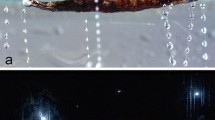Summary
Feeding reactions of Triturus vulgaris and Salamandra salamandra on light-spot-dummies were investigated.
-
1.
Feeding behaviour is released not only by a moving light spot, but also by a stationary spot when it is flickering rhythmically.
-
2.
The releasing value of flickering dummies depends on flicker frequency. Most reactions appear between 2 and 10 light stimuli per second. Frequencies of 0 and 14/sec do not release any answer. (Fig. 2)
-
3.
Flicker stimuli, even of optimal frequency, do not release as many reactions as moving stimuli. The releasing mechanism of the last feeding reactions is more specific than that of the first reactions (Fig. 3).
-
4.
After metamorphosis the responsiveness to flicker light decreases. In Salamandra salamandra this is more distinct than in Triturus vulgaris (Fig. 4).
-
5.
It is supposed that movement detecting neurons in the retina which are simultaneous on-off-units, are responsible for the releasing of the reactions observed. Filtering of stimuli in the retina do not suffice to explain the results. Central mechanisms must be supposed, which work up the informations coming from the retina.
Zusammenfassung
Es wurden die Beutefangreaktionen von Triturus vulgaris und Salamandra salamandra auf Lichtattrappen untersucht.
-
1.
Beutefangverhalten wird nicht nur durch sich bewegende Lichtflecken ausgelöst, sondern auch durch einen ruhenden Lichtfleck, wenn er rhythmisch aufleuchtet.
-
2.
Der Reizwert der Flimmerattrappe hängt von der Flimmerfrequenz ab. Zwischen 2 und 10 Lichtreizen/sec treten maximale Reaktionen auf, Frequenzen von 0 und 14/sec oder mehr werden nicht beantwortet (Abb. 2).
-
3.
Auch ein optimaler Flimmerreiz löst nicht so häufig aus wie ein Bewegungsreiz. Der Auslösemechanismus für die letzten Beutefanghandlungen ist dabei spezifischer als für die ersten Handlungen (Abb. 3).
-
4.
Nach der Metamorphose sinkt die Antwortbereitschaft auf das Flimmerlicht. Das ist bei Salamandra salamandra ausgeprägter als bei Triturus vulgaris (Abb. 4).
-
5.
Es wird vermutet, daß bewegungsspezifische Netzhautneurone, die zugleich on-off-Neurone sind, für die Auslösung der beobachteten Reaktionen verantwortlich sind. Die Reizfilterung in der Retina genügt aber nicht, um die Versuchsergebnisse zu erklären. Es müssen zentrale Mechanismen angenommen werden, die die Informationen aus der Retina weiterverarbeiten.
Similar content being viewed by others
Literatur
Ewert, J.-P.: Der Einfluß von Zwischenhirndefekten auf die Visuomotorik im Beute- und Fluchtverhalten der Erdkröte (Bufo bufo L.). Z. vergl. Physiol. 61, 41–70 (1968).
Gasche, P.: Beitrag zur Kenntnis der Entwicklung von Salamandra salamandra L. mit besonderer Berücksichtigung der Winterphase, der Metamorphose und des Verhaltens der Schilddrüse (Glandula thyreoidea). Rev. suisse Zool. 46, 403–548 (1939).
Glaesner, L.: Normentafel zur Entwicklungsgeschichte des gemeinen Wassermolches (Molge vulgaris), H. 14 von: Keibel, Normentafeln zur Entwicklungsgeschichte der Wirbeltiere. Jena: Fischer 1925.
Grüsser, O.-J., u. U. Grüsser-Cornehls: Neurophysiologische Grundlagen visueller angeborener Auslösemechanismen beim Frosch. Z. vergl. Physiol. 59, 1–24 (1968).
Hartline, H. K.: The response of single optic nerve fibres of the vertebrate eye to illumination of the retina. Amer. J. Physiol. 121, 400–415 (1938).
Himstedt, W.: Experimentelle Analyse der optischen Sinnesleistungen im Beutefangverhalten der einheimischen Urodelen. Zool. Jb., Abt. allg. Zool. u. Physiol. 73, 281–320 (1967).
Himstedt, W.: Die Reaktionen des Teichmolchs (Triturus vulgaris) auf intermittierende Lichtreize. Verh. Dtsch. Zool. Ges. Innsbruck: 1968 (im Druck).
Lettvin, J. Y., H. R. Maturana, W. S. McCulloch, and W. H. Pitts: What the frog's eye tells the frog's brain. Proc. Inst. Radio Eng. 47, 1940–1945 (1959).
Maturana, H. R., J. Y. Lettvin, W. S. McCulloch, and W. H. Pitts: Anatomy and physiology of vision in the frog (Rana pipiens). J. gen. Physiol. 43, 129–175 (1960).
Schipperheyn, J. J.: Contrast detection in frog's retina. Acta pyhsiol. pharmacol. neerl. 13, 231–277 (1965).
Schneider, D.: Beitrag zu einer Analyse des Beute- und Fluchtverhaltens einheimischer Anuren. Biol. Zbl. 73, 225–282 (1954).
Szabó, J.: Nahrungswahl und Nahrung des gefleckten Feuersalamanders (Salamandra salamandra L.). Acta zool. Acad. Sci. Hung. 8, 459–477 (1962).
Author information
Authors and Affiliations
Rights and permissions
About this article
Cite this article
Himstedt, W. Zur Funktion eines Reizfiltermechanismus im visuellen System von Urodelen. Z. Vergl. Physiol. 62, 197–204 (1969). https://doi.org/10.1007/BF00302283
Received:
Issue Date:
DOI: https://doi.org/10.1007/BF00302283




